Princess Mononoke: A Review
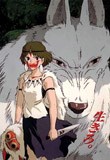
by ROGER EBERT
I go to the movies for many reasons. Here is one of them.
--I want to see wondrous
sights not available in the real world, in stories where myth and dreams are
set free to play.
--Animation opens that possibility, because it is freed from
gravity and the chains of the possible.
--Realistic films show the physical world;
animation shows its essence.
--Animated films are not copies of "real movies,"
are not shadows of reality, but create a new existence in their own right.
--True,
a lot of animation is insipid, and insulting even to the children it is made
for.
--But great animation can make the mind sing.
--Hayao Miyazaki is a great animator, and his "Princess Mononoke"
is a great film.
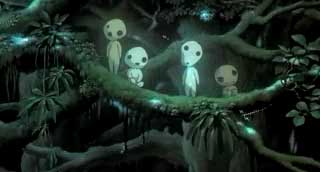
What is not to love about this assessment by Roger Ebert?!
His review continues:
Do not allow conventional thoughts about animation to prevent you from seeing
it. It tells an epic story set in medieval Japan, at the dawn of the Iron Age,
when some men still lived in harmony with nature and others were trying to tame
and defeat it. It is not a simplistic tale of good and evil, but the story of
how humans, forest animals and nature gods all fight for their share of the
new emerging order. It is one of the most visually inventive films I have ever
seen.
The movie opens with a watchtower guard spotting "something wrong in the
forest." There is a disturbance of nature, and out of it leaps a remarkable
creature, a kind of boar-monster with flesh made of writhing snakes. It attacks
villagers, and to the defense comes Ashitaka, the young prince of his isolated
people. He is finally able to slay the beast, but his own arm has been wrapped
by the snakes and is horribly scarred. A wise woman is able to explain what
has happened. The monster was a boar god, until a bullet buried itself in its
flesh and drove it mad. And where did the bullet come from? This is what Ashitaka must discover.
"It is time,"
says the woman, "for our last prince to cut his hair and leave us."
And so Ashitaka sets off on a long journey to the lands of the West, to find
out why nature is out of joint, and whether the curse on his arm can be lifted.
He rides Yakkuru, a beast that seems part horse, part antelope, part mountain goat.
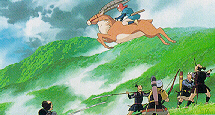
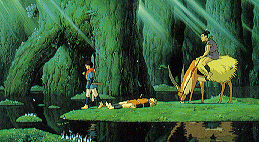
There are strange sights and adventures along the way, and we are able to appreciate
the quality of Miyazaki's artistry. The drawing is not simplistic, but has some
of the same "clear line" complexity used by the Japanese graphic artists
of two centuries ago, who inspired such modern works as Herge's Tintin books.
Nature is rendered majestically (Miyazaki's
art directors journeyed to ancient forests to make their master drawings) and
fancifully (as with the round little forest sprites).
There are also brief,
mysterious appearances of the spirit of the forest, who by day seems to be a
noble beast, and at night a glowing light. Ashitaka eventually arrives in an
area that is prowled by Moro, a wolf god, and sees for the first time the young
woman named San. She is also known as "Princess Mononoke," but that's
more a description than a name; a mononoke is the spirit of a beast.

San was a human child, raised as a wolf by Moro; she rides bareback
on the swift white spirit-wolves and helps the pack in their battle
against
the encroachments of Lady Eboshi,
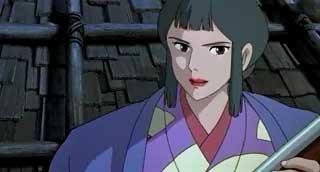
a
strong ruler whose village is developing ironworking skills and manufactures
weapons using gunpowder.
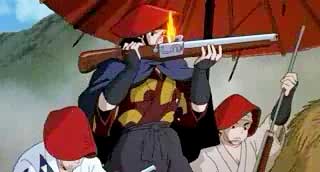
As
Lady Eboshi's people gain one kind of knowledge, they lose another, and the
day is fading when men, animals and the forest gods all speak the same language.
The lush green forests through which Ashitaka traveled west have been replaced
here by a wasteland;
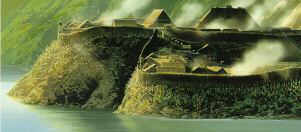
trees have been stripped to feed the smelting furnaces, and on
their skeletons, yellow-eyed beasts squat ominously. Slaves work the bellows
of the forges, and lepers make the weapons.
.
But all is
not black and white.
The lepers are grateful that Eboshi accepts them. Her people enjoy her protection. Even Jigo, a scheming agent of the emperor,
has motives that sometimes make a certain amount of sense. When a nearby samurai
enclave wants to take over the village and its technology, there is a battle
with more than one side and more than one motive. This is more like mythical
history than action melodrama.
The artistry in "Princess Mononoke" is masterful. The writhing skin
of the boar-monster is an extraordinary sight, one that would be impossible
to create in any live-action film. The great white wolves are drawn with grace,
and not sentimentalized;

when they bare their fangs, you can see that they are not friendly
comic pals, but animals who can and will kill.
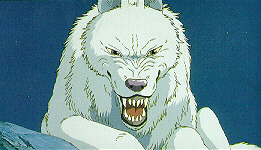
The
movie does not dwell on violence, which makes some of its moments even more
shocking, as when Ashitaka finds that his scarred arm has developed such strength
that his arrow decapitates an enemy.
Miyazaki and his collaborators work at Japan's Studio Ghibli, and a few years
ago Disney bought the studio's entire output for worldwide distribution. (Disney artists consider Miyazaki a source of inspiration.) The contract said Disney
could not change a frame--but there was no objection to dubbing into English, because of course, all animation is dubbed into even its source language, and as Miyazaki cheerfully observes, "English has been dubbed into Japanese for years." This version of "Princess Mononoke" has been well and carefully dubbed
with gifted vocal talents, including Billy Crudup as Ashitaka, Claire Danes as San, Minnie Driver as Eboshi, Gillian Anderson as Moro, Billy Bob Thornton as Jigo,
and Jada Pinkett-Smith as Toki, a commonsensical working woman in the village.
The drama is underlaid with Miyazaki's deep humanism, which avoids easy moral simplifications. There is a remarkable scene where San and Ashitaka, who have fallen in love, agree that neither can really lead the life of the other, and
so they must grant each other freedom, and only meet occasionally.
You won't find many Hollywood love stories (animated or otherwise) so philosophical. "Princess Mononoke" is a great achievement and a wonderful experience, and one of
the best films of the year.
NYT Review:
Princess Mononoke (1997)
NYT Critics' Pick This movie has been designated a Critic's Pick by the film reviewers of The Times.
September 27, 1999
FILM REVIEW: Waging a Mythic Battle to Preserve a Pristine Forest
By JANET MASLIN
While watching ''Princess Mononoke,'' a landmark feat of Japanese animation from the acknowledged master of the genre, it's very easy to understand the film's phenomenal popularity. Outdone only by ''Titanic'' as Japan's box-office champ, this intricate, epic fable is amazing to behold. No wonder the filmmaker, Hayao Miyazaki, is acknowledged as an inspiration among his American counterparts who have reinvented animated storytelling in the post-''Little Mermaid'' era.
''Not a day goes by that I do not utilize the tools learned from studying his films,'' John Lasseter (''Toy Story,'' ''A Bug's Life'') has said. Barry Cook and Tony Bancroft, whose ''Mulan'' shows strong evidence of Mr. Miyazaki's influence, are on the record with ''Miyazaki is like a god to us.'' ''Princess Mononoke,'' which was shown over the weekend as part of the New York Film Festival (an unusual distinction for an animated feature), explains what they mean.
This exotically beautiful action film features gods and demons locked in a struggle for the future of the unspoiled forest and an elaborate moral universe that Mr. Miyazaki has created. As such, it is a sweeping, ambitious version of the comic-book storytelling that engendered it. Frequent battle scenes, graphic enough to make a sharp distinction between ''Princess Mononoke'' and animation made for children, keep the story in motion. These are often breathtakingly rendered, but it is the film's stirring use of nature, myth and history that make it so special.
In a plot somewhat knotty for even the most ardent devotees of anime (comics-derived Japanese animation), the events of ''Princess Mononoke'' begin with an attack on a remote mountain village. A demonic wild boar, drawn as a furious tangle of pulsating wormlike strands and given the movements of a huge, terrifying spider, is the reason the young hero Ashitaka goes off to save the forests.
Those forests, imbued with a stirring, forthright sense of natural beauty, turn out to be filled with Mr. Miyazaki's fanciful inventions. The film is worth seeing just for the sight of its Forest Spirit, which takes animal-like form by day and roams the nights as a diaphanous Godzilla-like divinity with magical powers. The image of plants and flowers springing to life beneath the Forest Spirit's hooves as he walks is simple, meaningful and ravishingly presented.
The film features a superb blend of hand-drawn cels and fluid computer-generated motion, but its look is also gratifyingly understated. Notably absent are the little anthropomorphic touches that enliven most animation involving animals; this film's prevailing attitude toward its creatures is one of respect and wonder. And in welcome contrast to the chest-thumping animated musical, this film uses the grandeur of its score (by Joe Hisaishi) gracefully to enhance the momentousness of its story. Individual scenes are most intriguing for their rich variety in a film whose human characters (ironworkers, lepers, hunters, former prostitutes and Princess Mononoke, a feral young woman reared by wolves) are as varied as the woodland fauna.
Click Here for Two More Interesting Reviews
See also:
Princess Mononoke
from: http://www.toptenreviews.com/scripts/eframe/url.htm?u=http://lookingcloser.org/movie%20reviews/quickglancesH-P.htm#Princess%20Mononoke
The forest is important. It is alive. It is powerful. We need it. And it is suffering for our selfish ambition.
Princess Mononoke is an ambitious, complicated, and awe-inspiring fantasy of Japanese mythology, in which the spirits of the forest try and defend themselves against the destructive progress of humankind.
This is not Disney. There are selfish human beings on all sides, some of whom rise to the occasion of nobility, heroism, and conscience. The forest creatures themselves are not Bambi; they have their own selfishness, their own confusion and ignorance.
Human beings have through their foolishness awakened demons in the forest. The demons are coming to punish them for cutting down the trees and ruining their beautiful homes. They are fearsome: This is not an animated film for small children. These demons can only be exorcised through sacrifice, through humility, and through peace.
No, this is not a Christian mythology in its specifics, but at heart, love is still the answer, and only through sacrifice can peace be achieved. The world portrayed here exhibits a belief in pantheism. But it honestly represents the moral conflicts we face every day in our interactions with each other and with nature, and in doing so it is far more relevant than the moral oversimplifications prevalent in "Christian" storytelling, or Disney for that matter. There is a lot of truth here, for those with eyes to see and ears to hear. There is also a lot of love for the beauty of God's creation, a lot of respect for the divine, and a lot of compassion for even heartless human beings.
And did I mention the glorious animation? The main characters may be illustrated with that jittery, simplistic look of anime characters. But because they are, the world through which they move is allowed to distract us quite effectively. In fact, it's a breathtaking world, a forest full of surprises and secrets, full of life represented by a colorful array of fantasy creatures.
The main characters... there are many... are a fascinating mix. Ashitaka, who fights the forest's most frightening demon in the opening scene, walks away bearing a curse that will soon kill him. He cannot be healed, but he can search for the source of his curse. Where did this demon come from, and why was its hate so provoked?
On his quest for understanding he meets San, a warrior girl who lives with wolves. And he meets the Princess Eboshi, the leader of Irontown, who makes it her goal to kill the god of the forest. Then there is the strange little monk who follows Ashitaka, harboring his own suspicious motives. And over them all hovers the god of the forest, the manifestation of the forest's blessings, its beauty, and its abundance. This is not heresy... it is a way of talking about the life of the woods. There may be people who believe in gods such as this, but it would do us some good to think of the forest as a living, breathing, important thing, created by the One True God, and thus worthy of respect and love and compassion.
Perhaps the best reason to see this film is to see just how much imagination can come from an inventive storyteller. There’s ten times as much imagination in this film than in Star Wars: The Phantom Menace, and there’s a much more engaging and multi-faceted story to boot.
Hayao Miyazake has another feather in his cap, another proof that he’s the world’s greatest living cinematic imagination. Princess Mononoke is a classic animated work of art, even if it is about a half hour too long. It's the kind of thing that makes the standard American animated stuff that much more unsatisfying. It was bold of Disney to assist in bringing this film to the U.S., since it so outshines any Pocahontas, The Little Mermaid, or any other princesses of their own.
End of the Film Dialogue
Some dialogue from the end of the film after a bullet hits and
destroys the Shishigami's head:
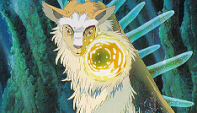
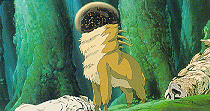
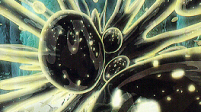
Ashitaka: I'm going to give the Shishigami its head back. Leave
it and get out of here!
San: Ashitaka, it's useless to talk to a human.
Ashitaka: I wish to return it with my own hands.
Jiko-Bou: I take no responsibility for what happens...
[Jiko-Bou opens the container. The head of the Shishigami is surrounded by a
glowing, golden liquid. As Ashitaka and San hold the head up, the liquid drips
from the head onto them, and leaves red-black marks (resembling those of Ashitaka's
curse) all over their bodies.]
Ashitaka: Shishigami! I give back your head! Please, calm down!
Jiko-Bou: It's coming, it's coming!
[Didarabotchi stretches its neck towards its head. As Didarabotchi bends over
them, Ashitaka holds San tightly. Ashitaka and San are enveloped in golden light.
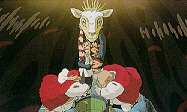
Back at Tatara Be, the townspeople stand in the lake, observing Didarabotchi.]
Kouroku: It stopped moving.
[Rafts appear on the lake, bearing Lady Eboshi, Gonza, the Tatara men, and Yakkuru.]
Woman: It's the men!
Toki: Eboshi-sama! Are you alright?
Gonza: Don't touch the wound!
[They see the body of Didarabotchi change its color from dark gray to gold,
then its usual blue. Having regained its head, Didarabotchi slowly stands up.
Then, the first sunray of morning hits it.]
Man: It's falling, it's falling!
[Didarabotchi slowly falls down on the lake. It flashes with a bright blue-white
light, and disappears instantly. As it disappears, a wind blows through. The
wind blows out the fire at Tatara Be, and blows away everything, including buildings,
trees, horses, and Samurai.]
Man: Don't let go!
[After the wind ceases, plants start sprouting all over. The earth burned by
Didarabotchi is now covered entirely with green. The Tatara people watch this
from the lake, stupefied. A leper woman looks at her hand, and realizes that
the mark of her disease has disappeared.]
Kouroku: Wow. The Shishigami was the bearer of life...
[Nudged gently by Yakkuru, Ashitaka wakes up to find himself and San lying on
a grassy plain. San is still in his arms. Ashitaka wakes her up.]
Ashitaka: San...San, look around you.
San: Even if the trees return, it won't be his forest anymore. The Great Forest Spirit (Shishigami) is dead now.
Ashitaka: Never. He is life itself. He's not dead. He's here right now, and he's trying to tell us something. He
is telling us it is time for both of us to live.
[Ashitaka looks at his right hand. The mark of his curse has almost disappeared;
only a light scar is left. San mounts one of the wolves.]
[NOTE: This is the crux of it, right? Two people witness the same set of events unfold and interpret them differently. For Ashitaka, the Forest Spirit cannot be killed. It will never die. Signs of life and new creation are all around them.
But San will not fall for this; she will not be deceived. The Forest we can see is no longer the Forest of the Spirits, or the Gods. So, in her eyes, it is all OVER. The magic has gone out of life!]
San: Ashitaka, I love you. You mean so much to me, but I cannot forgive humans for what they have done.
Ashitaka: That's fine. You'll live in the forest; and I'll go help rebuild Tatara Be. I'll be near. Yakul and I will
come and to visit you whenever we can. Alright?
[And this is the other piece. San can never forgive humans for what they have done. Nor can she trust them. So she cannot live among them. But Ashitaka needs to retain some hope for humanity so he will live among the people of Iron Town (Tatara Be), and help them rebuild. This time, Lady Eboshi will do better; she will make it a "good village this time."
She has many good points...so is she redeemable? Maybe humans can learn to live with animals and plants of the forest in a more sustainable fashion.]
So, San and Ashitaka clearly care for each other deeply but that is not necessarily enough for a happy "Hollywood" ending. They must agree to live apart and see each other from time to time, when they can. It's not ideal...but it is something!]
[San smiles and nods, then leaves with the wolves. At the ruins of Tatara Be,
Lady Eboshi is surrounded by her people.]
Eboshi: I'm so ashamed. The wolves (yama-inu) and San helped save us all. Someone go get Ashitaka; I want to
thank him.
Everyone, let's start over. We'll make this a good village.
[Jiko-Bou observes this from his boulder.]
Jiko-Bou: Oh man, I can't win against fools.
[At the shore of the Shishigami's pond, great dead trees look like white bones.
On the foot of them are sprouts, and a little Kodama appears among them. As
it clatters its head, the sound echoes through the forest...]
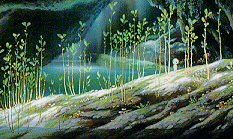
A couple of quotations that may be of some interest:
Miyazaki has been quoted as saying something to the effect that he cannot make a film that does not deal with the environment is some way; but he also says that he did not want to portray it as a case of good guys v. bad guys in Princess Mononoke. The sad part is that good, hardworking people are engaged in environemntal desecration all the time.
[Today] it is exactly the problem of the evironmental destruction we are facing on a global scale. This is the complexity in the relationship between humans and nature. And since this is a big theme of this film, I didn't want it to be a story about a bad guy. (quoted in Dani Cavallaro, _The Anime Art of Hayao Miyazaki_ (MacFarland & Co., 2006, p. 124)
Another interesting quote comes from Helen McCarthy, _Hayao Miyazaki: Master of Japanese Animation_ (Stonebridge Press, 1999):
Miyazaki is making a film about love, the extent to which love involves loss of many kinds, and how that loss can be borne. San and Ashitaka, the human embodiments of love and loss, come to an agreement that is ideal for neither but respects both. She will continue to live in the forest, in the world she loves, with the few survivors of her doomed family of gods, and the lovers will meet each other from time to time, halfway between her world and his. There are no guarantees as to whether the relationship will last, but they have just seen how promises can be broken, gods die, and forests wither and grow again; they are no longer so naive as to ask for guarantees. If we could find a way to allow nature its own space and relate to it in love and respect rather than seek to bend it to our will and our need, perhaps man and nature could get along. There are no guarantees, but there is hope. (200-201)
Princess Mononoke
by Hemanth Kissoon, February 2008
This is the film that got me into Hayao Miyazaki and Studio Ghibli. Princess Mononoke is powerful, surreal and imaginative. That coupled with an allegorical environmental message – a decade ahead of its time, compare George Miller's overt Oscar-winning penguin tale Happy Feet. Most cartoons wear their titles with clear reference to their subject, however Princess Mononoke is more intriguing, as it follows the travails of Prince Ashitaka (Billy Crudup – Almost Famous, Big Fish and The Good Shepherd) for the majority of the film.
Written and directed by Miyazaki and released in 1997, the movie opens on a mountainous forest range with swirling mist and a narrator revealing this to be an ancient time when humans and beasts lived in harmony, but then the forests started to be cut down; the gods lived there and protected the forests. Clearly referring to Japan's and the world’s industrialisation and devastation to the environment, nature in this story fights back.
There is something wrong outside the village where the Emishi people reside, a people on its last legs thanks to the emperor wiping many of them out. Prince Ashitaka riding his trusty red elk, Yakul, warns the villagers to get back to their homes. Tension is ably built as something ominous approaches rapidly. A creature – a demon - bursts through the stone wall on the outer edge of the community. He is scary and unpredictable due to his strength, speed and original design – a huge boar that is covered with a skin of living worms (which seem linked yet independent) that kill everything it touches. It is an exciting action sequence. Brave Ashitaka saves the village by killing the demon but is injured. He is touched and cursed, doomed to an eventual painful death. As the creature dies it warns that humans will feel his hate and suffer as he has suffered.
The lady shaman of the village reads her stones which reveal that the creature was a Boar God King with a poisonous ball of iron inside his body driving him to madness. The hate consumed him turning him into a demon. The Boar God King came from the west of the country. Ashitaka, the last prince of the Amishi tribe, must leave amid much sadness. If he finds the Forest Spirit in the west his mortal injury may be cured.
The Prince is not the only one who wants to find the Forest Spirit. A monk, Jigo (Billy Bob Thornton – Bad Santa, Armageddon and The Man Who Wasn't There), is seeking to cut off its head to give to the emperor for a pardon, as the emperor believes he will be made immortal. Lady Eboshi (Minnie Driver – Grosse Pointe Blank, Owning Mahowny and Good Will Hunting), leader of Iron Town, is constantly being harangued by the animals of the forest due to her harming the area with her iron works, and she believes the death of the Forest Spirit will free Iron Town to be even more prosperous.
Thrown into the mix are Lord Asano and his samurai who ambush villages, killing and stealing, now wanting Iron Town for himself. Then there is Princess Mononoke herself, attempting to protect the forest with the Wolf Goddess Moro (Gillian Anderson – The X-Files, The House of Mirth and The Last King of Scotland).
Princess Mononoke is a heady mix of characters and ideas, portrayed with stunning detail and verve - there are images of walking on water, unspoilt countryside, ferocious battles and animals arguing their cause. At 128 minutes this is longer than most family films, though packed with more in its running time than most cartoons. There are themes of harmony, compassion, hate, fear, greed, the cycle of life and hope. There is no simple moralising, for example, Lady Eboshi rescues women from brothels – she is not a simple one-dimensional baddie.
Continuing from his earlier Nausicaa of the Valley of the Wind, Miyazaki has fashioned a dream-like wake up call, one of the best animations ever made.





